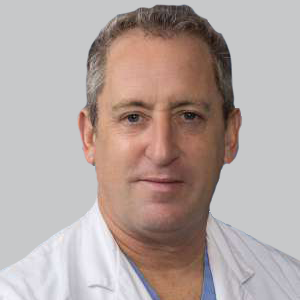Article
NeuroVoices: Vineet Punia, MD, MS, on Responsive Neurostimulation in Older Adults
Author(s):
The neurologist from Cleveland Clinic discussed his study presented at AAN 2021 involving the use of responsive neurostimulation in older adults with drug-resistant focal epilepsy and further expanding research in this space.
Vineet Punia, MD, MS

Researchers at Cleveland Clinic performed a single-arm retrospective study of both elderly and young patients with drug-resistant focal epilepsy (DRE) treated with responsive neurostimulation (RNS) therapy and used change in seizure frequency compared to pre-implant baseline as the primary outcome. Led by Vineet Punia, MD, MS, the findings showed that RNS is a feasible, and safe therapy for older adults with DRE who cannot undergo epilepsy surgery.
To date, there has been little to no literature published examining the effects of RNS in elderly patients with DRE. The study included 57 total patients, 12 of whom who were at least 50 years or older at the time of RNS implantation, and it was noted by Punia et al that multi-center, larger studies are needed to better understand the efficacy and utility of RNS in this patient population.
Punia, a neurologist from Cleveland Clinic, took the time to discuss his research on a new iteration of NeuroVoices. He provided his insight on the significance of the findings and how they may shape future endeavors into this area of research, while stressing the need for continued larger efforts.
NeurologyLive: What is the significance of these results, and how should clinicians interpret these data?
Vineet Punia, MD, MS: The responsive neurostimulation has been approved for use in people with drug resistant epilepsy who cannot undergo a receptive epilepsy surgery because they either have more than 1 focus of epilepsy origination or if the source of their epilepsy is close to a region that may cause a deficit, such as language, if it were to be resected. The pivotal data from the trial that led to the approval of RNS comes from typically younger adults. The average age of the patient in that clinical trial was around 30 to 35 years old.
As we know, our population is getting older and we’re living in a very rapidly aging society. It’s quite likely that soon enough, there will be older adults, and even elderly people who may be candidates for the RNS device. The problem is we do not have a lot of data on whether it is safe in those patients as well as how effective it might be. That’s the primary reason that motivated us here at Cleveland Clinic. We considered older adults as people who are 50 years old and above, which is quite subjective. In my opinion, even a 60-year-old is not as old in 2021. But still, for the sake of starting to understand this phenomenon of how this device would help older adults, we considered them at least 50 years and older while those below 50 years were counted as younger adults. We compared the experience that we have in these patients to see if it’s safe and effective or not.
Ultimately, what did these findings suggest?
We had a total of 55 patients in the study, 11 of which who were 50 years or older at the time of implantation of the RNS, and 44 younger adults. What we found was that despite almost double the duration of epilepsy in older adults, along with having significantly more comorbidities such as hypertension, diabetes, and things like that, the older adults had similar outcomes in terms of seizure control as compared to the young adults.
Secondly, there’s always a concern for safety when we are operating on older individuals and implanting this device, which is a chronic device that they would carry around in their life. We found out that it was equally safe or, in fact, safer in the small cohort. When I mean safer, there were 4 younger adult patients where explantation was required, and 3 of those patients developed a long or late infection. However, in none of the older adults, we faced this problem. None of the patients in the older cohort required explantation. Overall, it seemed safe and well-tolerated.
One interesting point was that in terms of medication burden, older adults were able to come off medication in some cases. In the younger adult group, 45% of patients required addition of medication to achieve seizure control. The overall seizure burden significantly reduced in older adults who underwent honest therapy compared to younger adults. Probably, it may also help reduce the seizure medication burden on older adults.
You concluded that larger studies are still required—what specific measures need further observation?
This is a single-center study with a small number of patients. There are only 11 patients who are older than 50 years of age. We need a multicenter collection of data to gather more patients so that we’re more confident of our findings and see if our experience is shared by other centers or not. Those findings, with larger numbers, will give us more confidence in recommending RNS therapy to older patients.
Are there other advantages of RNS that may still be unclarified at this point?
Personally, I would like to see its effects or benefits in cognition. We know that after epilepsy surgery, there are some patients who have cognitive deficits. There have been some early signals that show that people who undergo honest therapy are able to preserve their cognition and maybe improve. You want to see the long-term outcomes in terms of cognition or what happens to cognition in patients who under RNS implantation. Similarly, we need more long-term data on the mood outcomes of how the mood disturbances play out in these patients because that’s important as well.
We do not have a lot of data on these outcomes at the moment. There was a recent publication of the 10-year experience of the patients who underwent the aforementioned pivotal trial. Maybe if there was a subpopulation analysis looking at different patient populations of either temporal versus extra temporal, along with looking at other areas where honest therapy was implanted could help. Having those long-term subgroup analysis as well as subgroup analysis based on age, would be helpful in terms of understanding the long-term goals. We would hope that the patient may need this data in case they need a replacement in the long-term. We need that kind of data to recommend the patient to have that implanted in them and walk around with that device.
Transcript edited for clarity. For more coverage of AAN 2021, click here.




